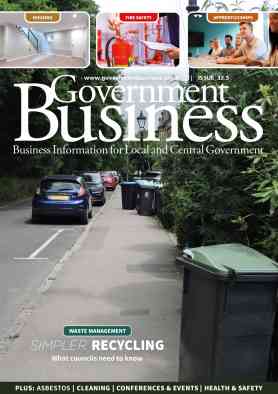Concrete Canvas Ltd is proud to be exhibiting at the International Security Expo for the first time, as we celebrate our 20th year in business.

Overcoming public sector FM challenges: strategies for a resilient future
With shifting regulations, budget constraints, and the growing need for sustainable solutions, public sector facilities managers face a complex landscape. Neil Everitt from IWFM expores the key challenges from skills shortages to technology adoption, and highlights the strategies and collaborations essential for shaping a more effective, data-driven, and future-ready public estate
The new government has been in power for less than a year and the facilities management (FM) sector faces a complicated public sector landscape. Changing compliance and regulation, the need for better data and technology, aging buildings, publicity around PFI performance and handback, net zero and sustainability action, all within the context of constrained budgets and growing demand.
The UK Government recognises the critical role of FM in public sector operations and has identified the need for a more accredited property workforce (achieving 90 per cent accreditation of FM, Workplace and Maintenance Senior Practitioners and Leaders with an approved property professional body by 2030). Among the 7,000 property professionals currently employed across government, approximately 20 per cent are in some way aligned to the FM profession.
Working together, IWFM and the Cabinet Office seek to close this gap by encouraging professional accreditation and aligning with the Government’s commitment to strengthening capability in property management. Together, the ambition is that by 2030, public sector property professionals are known for industry leading and commercial expertise, and business strategies are informed by high-quality property data and insight. This is in line with Mission 3 of the Government Property Strategy.
FM of the future
With the Government expressing new support for public services, workplace and facilities managers (WFMs) have an opportunity to build a public sector estate fit for tomorrow – but not before embracing the best solutions to existing challenges.
For instance, the skills gap is a pressing concern. Some would say it’s a crisis. Recruiting and retaining talented professionals into FM, especially those with expertise in sustainability technology and data analysis, is proving to be increasingly difficult. 2024’s sector spanning IWFM Market Outlook Survey (MOS) report reflected this issue for WFMs in central and local government.
Investing in apprenticeship programmes, internships and mentorship initiatives – all offered by IWFM as the sector’s standard-setter – cultivates a skilled workforce and bridges the gap between education and practice. With IWFM, professionals at every career stage can reskill and upskill as they navigate the sector, plus membership unlocks key benefits in the form of exclusive insight, networking and more.
Building backlog
On 22 January, the National Audit Office (NAO) published a report featuring IWFM input on the UK Government’s building maintenance backlog, which amounts to a cost of at least £49 billion. The negative impact goes beyond cost, including reduced government productivity and hampered public service delivery. In addition, the report stated how poor property conditions imperil civil service productivity, staff retention and the ability to meet sustainability targets.
From the 2024 MOS report, around 46 per cent of central and 39 per cent of local government WFMs reported no change in workspace investment over the last 12 months. While roughly a third in both sectors saw increases,
no one reported significant increases. However, a concerning picture emerges for local government, with 22 per cent reported decreases in workspace investment, significantly higher than the 8 per cent reported by central government. WFMs should adopt a lifecycle approach to asset management, moving beyond reactive repairs to preventative maintenance and strategic upgrades. This includes implementing new technologies and leveraging data analytics to help predict future infrastructure needs and inform long-term capital planning decisions, ensuring resources are allocated effectively to prioritise critical repairs and replacement.
Collaboration and data
Finally, fostering collaboration between FM teams, contractors and building owners throughout a building’s life cycle is crucial to developing comprehensive strategies that address the specific needs of aging infrastructure and ensure its continued functionality and safety. In Q2, IWFM research on asset management and safety management systems will provide actionable resources for professionals to optimise their strategies and processes.
However, inefficient data and technology usage still plagues WFMs and overcoming this challenge requires a multi-pronged approach. First, a comprehensive assessment of existing data silos and technological gaps is crucial, identifying areas where information isn’t readily accessible or integrated.
Centralising data, coupled with robust analytics capabilities, empowers data-driven decision-making, enabling managers to proactively identify inefficiencies, predict maintenance needs and optimise space allocation to improve operational efficiency and reduce costs. Furthermore, prioritising data governance and establishing clear protocols for data collection, storage and security are essential for ensuring data accuracy and reliability, fostering trust in the insights derived from the technology investments. IWFM is supporting the Information Management Initiative and is expecting to produce guidance in this area in the future.
Technology
From the 2024 MOS report emerges a silver lining in technology investment, with both central (53 per cent) and local (56 per cent) government WFMs reporting increases over the past year. However, even in this area, local government WFMs were more likely to experience decreases (17 per cent) compared to central government (8 per cent), though notably, no local government WFMs reported significant decreases, whereas a small percentage of central government did. This is reflected in IWFM’s message to the sector from the report: keep investing – the tide is turning.
As those involved will be all too aware, central and local governments must carefully navigate the transition from Private Finance Initiative (PFI) to in-house management. As addressed in Facilitate’s 2025 PFI Handback Handbook, the UK wave of PFI contract handbacks requires careful management by FM service providers and public sector clients.
Early preparation is crucial for a smooth transition of assets back to public ownership, including addressing asset condition, information management, service continuity and technology transfer. While challenges such as resource constraints and contractual ambiguities exist, proactive mitigation strategies and positive stakeholder relationships overcome the complexities and create an opportunity to modernise assets, incorporate sustainability measures and leverage data for informed decision-making in the future.
Net zero and sustainability goals
WFMs face a significant challenge in achieving net zero and sustainability goals, but several avenues offer promise. One key strategy involves implementing energy efficiency measures across their building portfolios. This includes upgrading outdated systems with more efficient models, installing smart building technologies to optimise energy consumption and adopting renewable energy sources like solar panels where feasible.
Furthermore, embracing circular economy principles for procurement, focusing on durable, repairable and recyclable materials, and minimising waste through effective waste management programmes can drastically reduce environmental impact. Finally, robust data collection, monitoring and reporting on energy consumption and waste generation are crucial for tracking progress, identifying areas for improvement, and demonstrating accountability.
This data-driven approach, coupled with continuous improvement strategies, will be vital for public sector WFMs to succeed. From the 2024 MOS report, central government WFMs reported a large number of increases within investment in carbon reduction solutions over the last 12 months. 62 per cent reported increases and a further 8 per cent reported significant increases. Local government also saw increases with 39 per cent increasing and 11 per cent significantly increasing.
All the remaining central government WFMs reported no change to investment in this area with none reporting decreases. 11 per cent of local government WFMs saw a decrease.
Overcoming compliance and regulation challenges requires proactive planning, robust documentation and continuous improvement. With IWFM, WFM teams benefit from comprehensive training opportunities to ensure staff full compliance with current laws and regulations relevant to their facilities and roles. Stay engaged and look forward to the release of the 2025 IWFM Market Outlook Survey report, due to be published this Easter.
IWFM is committed to supporting and enhancing public sector professionals in their important work. We will continue to advocate for the importance of FM, provide access to valuable resources and training and facilitate collaboration and knowledge sharing across the sector. By working together, we can ensure that the public sector can be at the forefront of FM innovation and delivers exceptional services.
To discover more about IWFM’s activities and offering, please contact neil.everitt@iwfm.org.uk
Company Focus
Event Diary
Join us for the landmark 10th Anniversary of the London Build Expo, the UK’s largest and most influential construction and design show.
Retail Supply Chain & Logistics Expo returns to Excel London across 12-13 November, once again bringing together the world of logistics, supply chain, eCommerce and retail innovation for two dynamic days of opportunity.
Every sport, from grassroots football to world-class tournaments, depends on one constant: high-quality playing surfaces and well-maintained green spaces.
Supplier Profiles
Bauder Accepts Keys to its New UK Distribution Centre at Gateway 14
Bauder marked a major milestone in its UK expansion with the official handover of a brand
Words of World: Bridging language barriers with excellence
At Words of World, we specialise in professional translation and interpreting, d
Latest Features
The British Institute of Cleaning Science (BICSc) and the Cleaning & Support Services Association (CSSA) have successfully completed a groundbreaking project aimed at exploring the future of cleaning. This collaboration marks a significant milestone in the cleaning industry, reflecting a shared commitment to embracing innovation with confidence.
The Crown Commercial Service’s (CCS) new framework on Language Services (RM6302), dealing with translation, transcription and interpreting, is live, running from 7th May 2025 to 6th May 2028.









